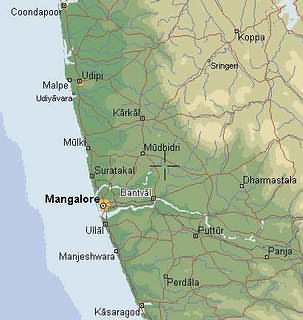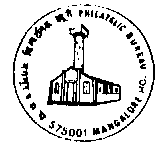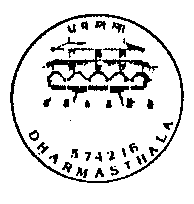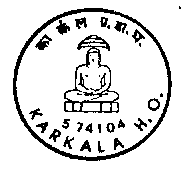 |
the postal history of dakshina kannada and its pictorial cancellations K. P. Achar, Editor IndDak |
 |
the postal history of dakshina kannada and its pictorial cancellations K. P. Achar, Editor IndDak |
 |
Every District has its own story
to tell. Dakshina Kannada District is no exception. It is
the pride of the Karnataka State. With its abundant
rains, luxurious vegetation, salubrious climate, grand
panorama of coconut groves and sandy beaches and people
endowed with intelligence and industry, the District
holds a unique position in the country. The name of South Kanara (Dakshina Kannada) is derived from a wrong designation given to this region by the Portuguese in the seventeenth and eighteenth centuries. They found the people speaking Kannada and therefore called the region Canara. The region then included what today is Uttar Kannada. The English who took over the area after the death of Tippu Sultan in 1799 continued this nomenclature. |
| Until 1860, Canara -
South and North were under a single Administration. In
that year, the British split the area into South Canara
and North Canara, the former being retained in Madras,
while the later was made a part of Bombay Province in
1862. Coondapur taluk was earlier included in North
Canara, but was re-included in South Canara later.
Kasargod taluk was transferred to Cannanore District when
the States were reorganized in 1956. In 1876 the District had only 5 taluks, namely Mangalore, Coondapur, Udupi, Kasargod and Uppinangady. Subsequently Karkala, Belthangady, Bantwal and Sullia taluks were formed. Uppinangady was renamed as Puttur taluk. |
| The history of Post
Offices in the District dates back to 1858. The entire
Canara District had only one Post Office at Mangalore.
The next oldest Post Office appears to be Mangalore
Bunder Post Office. Letterboxes at important places in
Mangalore were planted in 1885. Somewhere in 1911 one RMS
Sorting Office started functioning in the premises of
Mangalore Railway Station. Till then Madras Mails were
diverted through Kadur. Gradually in 1918 Jutka services
replaced some of the important runner lines on
Puttur-Udupi-Coondapur and Belthangady lines. Buses were
utilized for conveyance of mails during 1929. Important
lines were Mangalore - Coondapur - Agumbe - Karkala
lines. Till 1936 there were only 3 Motor lines. All Post Offices in the District were under the control of Superintendent of Post Offices Calicut till 1897, Superintendent of Post Offices Shimoga Division upto 1907 and Superintendent of Post Offices Westcoast Division (later known as Malabar Division) upto Jan 2,1949. South Canara Postal Division was formed on Jan 3,1949. Sri Venkatesan was the first Superintendent of Post Offices of the Division. Sri Keshava Rao was the Postmaster, Mangalore Head Office. Then there were 1 Head Office, 24 Sub Offices and 170 Branch Offices. The Division was bifurcated as Mangalore and Udupi Divisions on April 2,1973. Udupi Division had 2 Head Offices, 80 Sub Offices and 196 Branch Offices. Mangalore Division saw another bifurcation when Puttur was formed on July 5, 1979. Puttur Division had 3 Head Offices, 86 Sub Offices, and 175 Branch Offices. Today Mangalore Division has 1 Head Office, 29 Sub Offices, and 55 Branch Offices, Puttur Division has 3 Head Offices, 130 Sub Offices and 256 Branch Offices and Udupi Division has 3 Head Offices, 86 Sub Offices and 174 Branch Offices. |
| Along with the upgradation of Mangalore Head Office to Gazetted status, a Philatelic Bureau was opened to cater to the needs of Philatelists of the District. It has a Pictorial cancellation depicting a lighthouse. No documentary or other evidence is available as to who constructed the lighthouse. But it is generally attributed to Hyder Ali and Tippu Sultan. Introduced on September 11, 1989. |  |

|
The Philatelic counter at Manipal, a township consisting of distinguished educational and financial institution also has a pictorial cancellation. The cancellation depicts Venugopalaswamy Temple. The uniqueness of the temple is its multireligious facade, in its dome resembles a mosque and the background spire reminds of a church. Introduced on December 4, 1988. |
| Udupi, the head quarters of the newly formed District has a permanent cancellation of lord Krishna - The idol is carved out of a black saligrama stone. The temple is said to be founded by Sri Madhwacharya, a Hindu saint of 16th Century. Introduced on January 23, 1985. |  |
 |
The temple town of Dharmasthala has also a pictorial cancellation. The Cancellation depicts Manjunatha Temple. This is a rare pilgrimage centre attracting Hindus, Jains, Christians and Muslims. However the uniqueness of Dharmasthala is settling of civic disputes. The Dharmadhikari (Religious Head) settles more disputes than any established court for dispensing justice. Introduced on January 1, 1989. |
| Karkala is the Jain pilgrimage centre. The main attraction is the 13m high monolithic Gomateshwara situated on top of a hill. the cancellation depicts a seated Thirthankara and was introduced on February 5, 1991. | 
|
| There are many other places in the District deserving pictorial cancellations and it is hoped that it will be done in due course |
Copyright (c) Dakshina
Kannada Philatelic Association
http://www.geocities.com/dakshina_kan_pa